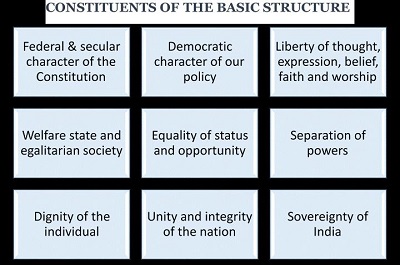Context-
The Keshavananda Bharti doctrine asserts that certain fundamental aspects of the Constitution are immune to Parliament's amending authority. While celebrated for protecting India's democratic principles, the doctrine has also been criticized for its indefinite scope and the possibility of judicial overreach.
The Genesis of the Doctrine: Dietrich Conrad's Crucial Role
Before delving into the debate surrounding the Basic Structure Doctrine, it's essential to recognize the significant contribution of German jurist Dietrich Conrad. In 1965, almost eight years before the Kesavananda Bharati judgment, Conrad delivered a lecture in which he questioned the limits of the power to amend the constitution. He posed thought-provoking scenarios, such as the potential abolition of fundamental rights or the reintroduction of autocracy through amendments. These extreme hypotheticals underscored the necessity of having checks and balances on all powers, including the power to amend.
The Doctrinal Foundations: Arguments in Favor and Challenges
There are three key arguments in favor of the Basic Structure Doctrine:
- Limitations on all powers: All institutions, including the judiciary, should have limitations on their power. The doctrine ensures that Parliament's amending power is not absolute and serves as a safeguard against potential abuses. The historical experience of the Emergency, with its violations of human rights and civil liberties, further strengthens the need for such judicial checks on the legislature.
- Protecting fundamental features: The doctrine recognizes the core principles of the Constitution and protects them from amendments or legislative interventions. This ensures that the values of democracy, secularism, and individual rights remain enshrined in the Constitution.
- Judiciary as the interpreter: Under the Indian Constitution, the Supreme Court holds the power of interpreting the Constitution and its meaning. This position allows the court to formulate doctrines like the Basic Structure Doctrine to uphold the principles of the Constitution.
However, the doctrine also faces challenges:
- Open-ended nature: The lack of a clear definition of the "Basic Structure" can lead to arbitrariness in judicial decision-making. This raises concerns about potential misuse of power by the judiciary.
- Legitimacy concerns: In an information age where public trust in democratic institutions is crucial, the judiciary needs to ensure the legitimacy of its judgments. Ambiguous formulations of doctrines like the Basic Structure can erode public confidence in the judiciary.
Suggestions for Improvement
To address the challenges and strengthen the Basic Structure Doctrine, the following suggestions are proposed:
- Defining the Basic Structure: The Supreme Court, in collaboration with legal experts and stakeholders, should undertake a comprehensive exercise to define the core elements of the Basic Structure with greater clarity and precision. This would provide a framework for future judicial decisions and reduce the risk of arbitrariness.
- Transparency in decision-making: The Supreme Court should increase transparency in its decision-making processes related to the Basic Structure Doctrine. This could involve providing detailed written judgments, allowing access to court documents, and engaging in public hearings on significant cases.
- Public dialogue: Fostering open and inclusive public dialogue on the Basic Structure Doctrine is crucial for building public understanding and support. This could involve conducting public consultations, organizing educational programs, and engaging with civil society organizations and the media.
- Constitutional Review Commission: The establishment of a periodic Constitutional Review Commission, comprised of legal experts and representatives from diverse sections of society, could be considered. This commission could undertake regular reviews of the Constitution, including the Basic Structure Doctrine, and recommend amendments or reforms to ensure its continued relevance in an evolving society.
Justice Nambiar's Doctoral Thesis: A Vision for the Future
Justice A K Jayasankaran Nambiar's doctoral dissertation, "The Judicial Role in Constitutional Protection: Examining the Legitimacy of Basic Structure Review in India," offers valuable insights into the future of the doctrine. He argues for a "new imagination" of the doctrine, one that is clearer, more transparent, and more grounded in the constitutional text.
Conclusion
The Basic Structure Doctrine has played a vital role in safeguarding Indian democracy and its core values. However, it remains a complex and evolving legal concept. By embracing transparency, engaging in public dialogue, and actively seeking ways to refine and clarify the doctrine, the judiciary can ensure its continued effectiveness in protecting the fundamental principles of the Indian Constitution. Furthermore, implementing the proposed suggestions for improvement can further strengthen the doctrine and enhance its legitimacy in the years to come.
|
Probable Questions for UPSC Mains Exam
|
Source – The Hindu







